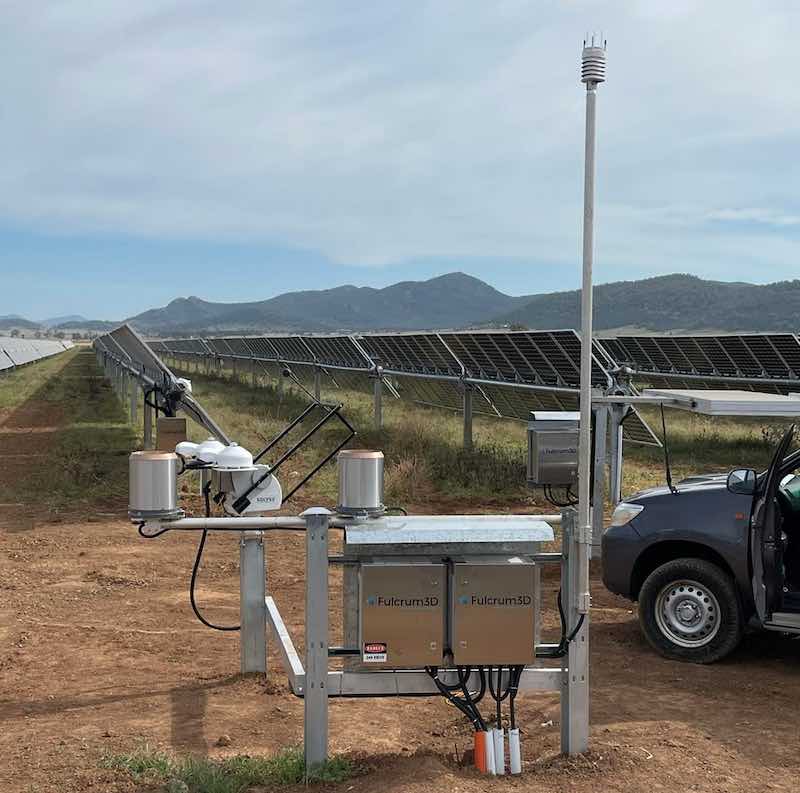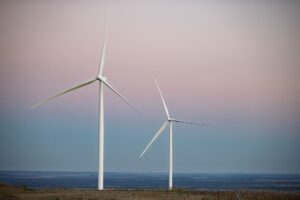Australian-made advanced solar monitoring hardware, designed to ensure that solar farms using cutting edge bifacial panels are meeting their performance goals, has been rolled out for the first time at a solar farm in north-eastern New South Wales.
Fulcrum3D has supplied its high tech Met Stations to the 154MW (DC) Gunnedah solar farm, making it the first utility-scale bifacial PV project in Australia to use the technology, and the first to be fully compliant with new 2021 international monitoring standards that factor in bifacial panels.
The Gunnedah project – which was built by PCL Constructors using bifacial panels and single axis trackers – joined the grid west of Tamworth mid-way through this year and began making its way through a series of “hold points” on the path to full generation.
The use of bifacial solar panels, in combination with sun-tracking technology, is becoming increasingly popular among large-scale project developers, to capture and convert as much of the sun’s rays as possible, including from light reflected from the ground.
Manufacturers have promised bifacial panels can deliver anywhere between 5% to 20% more power output in the right circumstances – the percentage gain can be affected by the lie of the land hosting the solar farm and changes in reflection angles from season to season.
Keeping tabs on these promises is the new international standard – IEC 61724-1 (Edition 2) – which in July this year introduced requirements for monitoring of bifacial solar systems, which involves accurately determining the performance of the rear-side of the panels.
Fulcrum3D CEO Dr Colin Bonner told RenewEconomy this is not a trivial matter. In fact, the new standard highlights the difficulty in accurately determining this rear-side solar resource, due to shading patterns, mounting structures, surface properties and seasonal variations.
“With a typical monofacial panel, you’re just looking at what sunlight is passed through the atmosphere
and onto each panel,” Bonner said.
“Whereas with bifacial panels you also need to take into account how the sunlight interacts with the ground and the PV arrays themselves before it illuminates the rear side of the panel.
“You can get far more site-specific variances using bifacial panels and that’s why the monitoring is so much more complicated, because the near-ground scattering to the back of panel may vary within rows or within a cluster of the solar farm – or even seasonally as well.
“If you have a wet season, with nice green grass, that’s going to have a different scattering coefficient to red dust, for example,” Bonner told RE.

Fulcrum3D’s solar monitoring stations – the company actually got its start in monitoring solutions for wind farms – incorporate standard parameters with direct and diffuse irradiance quantification, which is achieved by real-time IV Curve tracing of “spectrally matched” reference panels.
“Fulcrum3D I-V Curve Soiling Stations were designed to acquire a full trace of the I-V Curve to estimate the soiling losses from short-circuit currents and detect homogenous soiling across the panels via maximum power point measurements,” the media statement explains.
“This hardware is directly transferrable to dual-panel monitoring in bifacial systems to separate the front and rear illumination.”
Bonner says data on the meteorological conditions throughout the solar farm is presented to SCADA [Supervisory Control and Data Acquisition] in real time and used for grid connection requirements and on-site short-term forecasting.
And all of this adds up, particularly when you are financing, building, commissioning and contracting the output for a large-scale, grid-connected solar project that will generate hundreds of gigawatt-hours of energy a year.
“[Accurate bifacial solar monitoring] is actually quite material to what your yield assessments will be,” says Bonner.
“And it then starts driving the actual solar farm design, itself. So, if you are receiving an extra 10% or 20% rear illumination on the back of the panel, you’re going to have about 6% more energy annually.
“The additional current from the rear-side illumination can impact your cable size, combiner boxes and cable infrastructure. There are also options to optimise the array mounting and layout to increase the rear-side yield. Accurate onsite monitoring allows for validation of the initial desktop designs of the solar farm.
“So that’s where we’re getting to… It’s a rapidly changing industry and the assets being built now are going to be key to ensuring the long term returns out to our 2050 future. So it’s quite important that the solar farms being built now are built properly to the best possible standards, such that the projects remain solid long-term investments,” he said.








